Proposing a Wetland-Based Economic Approach for Wastewater Treatment in Arid Regions as an Alternative Irrigation Water Source
Abstract
:1. Introduction
2. Materials and Methods
2.1. The Study Area
2.2. Water Quality Data
2.3. HSSF- and VF-CW’s Model Descrpition
2.4. Proposed HSSF and VF-CWs Construction Details
2.5. Modeling HSSF-CW and VF-CW Efficiencies Using the P-K-C*
- Use the input model data summarized in Table 2 and obtain the HSSF and VF-CWs areas for the BOD, TP, and FC by utilizing Equation (1).
- Obtain the hydraulic residence time (RT) from Equation (3).
- The design area is the area corresponding to the maximum RT in days.
- Determine the surface loading rate (q) from Equation (3).
- Obtain the length and width in (m) for the HSSF and VF-CWs based on an aspect length-to-width ratio of 1:1
- Divide the CW width into n cells based on a cell width of 8.0 m, and by doing so, the number of cells (n) = width/8.0.
2.6. The Cost Function for Treating Wastewater
3. Results
3.1. HSSF and VF-CWs Removal Efficiencies
3.2. HSSF and VF-CWs Sizing Design Curves
3.3. HSSF and VF-CWs Water Balance
4. Discussion
4.1. HSSF and VF-CWs Efficiencies
4.2. Cost Estimation Analysis
5. Conclusions
Author Contributions
Funding
Informed Consent Statement
Data Availability Statement
Acknowledgments
Conflicts of Interest
References
- Holding Company for Water and Wastewater (HCWW). Governorates datasheets. In 2030 Strategic Vision for Treated Wastewater Reuse in Egypt. Water Resources Management Program—CEDARE; AbuZeid M.K., CEDARE, Eds.; 2014. Nile Corniche, As Sahel, Rod El Farag, Cairo Governorate, Egypt. Available online: https://www.hcww.com.eg/ (accessed on 14 July 2022).
- Holding Company for Water and Wastewater (HCWW). Data and Statistics 2019. Available online: https://www. (accessed on 30 June 2022).
- MWRI, Ministry of Water and Irrigation. The National Water Resources Plan, 2037, Egypt. 2017. Available online: https://www.mwri.gov.eg/nwrpeg/index.php?option=com_content&view=category&layout=blog&id=34&Itemid=55 (accessed on 15 June 2022).
- Abdelazim, M.N. Unconventional water resources and agriculture in Egypt. In The Handbook of Environmental Chemistry; Springer: Cham, Switzerland, 2019. [Google Scholar] [CrossRef]
- Gabr, M.; Elzahar, M. Study of the quality of irrigation water in South-East El-Kantara Canal, North Sinai, Egypt. IJESD 2018, 9, 142–146. [Google Scholar] [CrossRef] [Green Version]
- Gabr, M. Evaluation of irrigation water, drainage water, soil salinity, and groundwater for sustainable cultivation. Irrig. Drain. Sys Eng. 2018, 7, 224. [Google Scholar]
- Mohamed, H.T.; Jaime, H.; Amgad, E.; Petra, H. Unpacking wastewater reuse arrangements through a new framework: Insights from the analysis of Egypt. Water Int. 2021, 46, 605–625. [Google Scholar] [CrossRef]
- Gabr, M.E. Study of reclaimed water reuse standards and prospects in irrigation in Egypt. Port-Said Eng. Res. J. 2020, 24, 65–75. [Google Scholar] [CrossRef] [Green Version]
- El-Hawary, A.; Shaban, M. Improving drainage water quality: Constructed wetlands-efficiency assessment using multivariate and cost analysis. Water Sci. 2018, 32, 301–317. [Google Scholar] [CrossRef] [Green Version]
- Gabr, M.E. Proposing a constructed wetland within the branch drains network to treat degraded drainage water in Tina Plain, North Sinai, Egypt. Arch Agron. Soil Sci. 2021, 67, 1479–1494. [Google Scholar] [CrossRef]
- Gabr, M.E. Design methodology for sewage water treatment system comprised of Imhoff’s tank and a subsurface horizontal flow constructed wetland: A case study Dakhla Oasis, Egypt. J. Environ. Sci. Health Part A 2022, 57, 52–64. [Google Scholar] [CrossRef]
- Sami, U.B.; Umara, Q. Implications of Sewage Discharge on Freshwater Ecosystems; IntechOpen: Rijeka, Croatia, 2021. [Google Scholar] [CrossRef]
- Tao, Z. Sewage—Recent Advances, New Perspectives and Applications; IntechOpen: Rijeka, Croatia, 2022. [Google Scholar] [CrossRef]
- Roberto, A.; Onintze, P.; Leire, G.; Mikel, M.; Leire, U.; Federico, M. Modelling and simulation of subsurface horizontal flow constructed wetlands. J. Water Proc. Eng. 2022, 47, 102676. [Google Scholar]
- Thalla, A.K.; Devatha, C.P.; Anagh, K.E. Sony, Performance evaluation of horizontal and vertical flow constructed wetlands as tertiary treatment option for secondary effluents. Appl. Water Sci. 2019, 9, 147. [Google Scholar] [CrossRef]
- Merriman, L.S.; Hathaway, J.M.; Burchell, M.R.; Hunt, W.F. Adapting the relaxed tanks-in-series model for stormwater wetland water quality performance. Water 2017, 9, 691. [Google Scholar] [CrossRef] [Green Version]
- Wojciech, D.; Beata, K.; Paweł, M.; Dariusz, B. Modeling of pollutants removal in subsurface vertical flow and horizontal flow constructed wetlands. Water 2019, 11, 180. [Google Scholar] [CrossRef] [Green Version]
- Hassan, I.; Chowdhury, S.R.; Prihartato, P.K.; Razzak, S.A. Wastewater treatment using constructed wetland: Current trends and future potential. Processes 2021, 9, 1917. [Google Scholar] [CrossRef]
- Gabr, M.E. Design methodology of a new surface flow constructed wetland system, case study: East South EL-Kantara Region North Sinai, Egypt. Port-Said Eng. Res. J. (PEERJ) 2020, 24, 23–34. [Google Scholar] [CrossRef]
- Kadlec, R.H.; Wallace, S. Treatment Wetlands, 2nd ed.; CRC Press: Boca Raton, FL, USA, 2009; Available online: https://www.routledge.com/Treatment-Wetlands/KadlecWallace/p/book/9781566705264 (accessed on 15 July 2022).
- Kadlec, R.H. The inadequacy of first-order treatment wetland models. Ecol. Eng. 2000, 15, 105–119. Available online: https://www.sciencedirect.com/science/article/pii/S0925857499000397 (accessed on 10 July 2022). [CrossRef]
- Laaffat, J.; Ouazzani, N.; Mandi, L. The evaluation of potential purification of a horizontal subsurface flow constructed wetland treating greywater in semi-arid environment. Proc. Saf. Environ. Prot. 2015, 95, 86–92. Available online: https://www.sciencedirect.com/science/article/pii/S0957582015000397 (accessed on 10 July 2022). [CrossRef]
- Mohammed, N.A.; Ismail, Z.Z. Prediction of pollutants removal from cheese industry wastewater in constructed wetland by artificial neural network. Int. J. Environ. Sci. Technol. 2021, 19, 9775–9790. [Google Scholar] [CrossRef]
- Samso, R.; García, J.; Molle, P.; Forquet, N. Modelling bio-clogging in variably saturated porous media and the interactions between surface/subsurface flows: Application to constructed wetlands. J. Environ. Manag. 2016, 165, 271–279. [Google Scholar] [CrossRef] [Green Version]
- Dittrich, E.; Klincsik, M.; Somfai, D.; Dolgos-Kov, A.; Kiss, T.; Szekeres, A. Application of divided convective-dispersive transport model to simulate variability of conservative transport processes inside a planted horizontal subsurface flow constructed wetland. Environ. Sci. Pollut. Res. 2021, 28, 15966–15994. [Google Scholar] [CrossRef]
- Austin, D.; Vazquez-Burney, R.; Dyke, G.; King, T. Nitrification and total nitrogen removal in a super-oxygenated wetland. Sci. Total Environ. 2019, 652, 307–313. [Google Scholar] [CrossRef]
- Vymazal, J. The historical development of constructed wetlands for wastewater treatment. Land 2022, 11, 174. [Google Scholar] [CrossRef]
- George, P.; Ioanna, Z.; Helen, K.; Anna, M.; Georgios, B.; Vassilios, A.T.; Ioannis, N. Efficiency of pilot-scale constructed floating wetlands in the removal of nutrients and pesticides. Water Resour. Manag. 2022, 36, 399–416. [Google Scholar]
- Al-Gheethi, A.A.; Norli, I.; Efaq, A.; Bala, J.; Alamery, R. Solar disinfection and lime treatment processes for reduction of pathogenic bacteria in sewage treated effluents and biosolids before reuse for agriculture in Yemen. JWRD 2015, 5, 419–429. [Google Scholar]
- Madleen, S.; Gabr, M.E.; Mohamed, M.; Hani, M. Random Forest modelling and evaluation of the efficiency of a full-scale subsurface constructed wetland plant in Egypt. Ain Shams Eng. J. 2022, 13, 101778. [Google Scholar]
- Mustafa, H.M.; Hayder, G. Recent studies on applications of aquatic weed plants in phytoremediation of wastewater: A review article. Ain Shams Eng. J. 2021, 12, 355–365. [Google Scholar] [CrossRef]
- Rashed, A. Treatment of municipal pollution through re-engineered drains: A case study, Edfina Drain, West Nile Delta. In Proceedings of the 11th International Commission on Irrigation and Drainage (ICID), International Drainage Workshop (IDW), Cairo, Egypt, 22–24 September 2012. [Google Scholar]
- Alexandros, I.S. The role of constructed wetlands as green infrastructure for sustainable urban water management. Sustainability. 2019, 11, 6981. [Google Scholar]
- Reetika, S.; Gupta, D.; Gurudatta, S.; Virendra, K.M. Efficiency of horizontal flow constructed wetland for secondary treatment domestic wastewater in a Remote Tribalarea of Central India. Sustain. Environ. Res. 2021, 31, 13. [Google Scholar]
- Chen, J.; Ying, G.G.; Liu, Y.S.; Wei, X.D.; Liu, S.S.; He, L.Y.; Yang, Y.Q.; Chen, F.R.; Fan-Rong, C. Nitrogen removal and its relationship with the nitrogen-cycle genes and microorganisms in the horizontal subsurface flow constructed wetlands with different design parameters. J. Environ. Sci. Health A Tox. Hazard Subst. Environ. Eng. 2017, 52, 804–818. [Google Scholar] [CrossRef]
- Molinos-Senante, M.; Hernández-Sancho, F.; Sala-Garrido, R. Economic feasibility study for wastewater treatment: A cost–benefit analysis. Sci. Total Environ. 2010, 408, 4396–4402. [Google Scholar] [CrossRef]
- MWRI. Reference Conditions for the Project of 1.5 Million Acres in Egypt; Ministry of Water Resources and Irrigation: Giza, Egypt, 2015. [Google Scholar]
- FAO. CROPWAT 8 Software by Land and Water Division. 2022. Available online: http://www.fao.org/land-water/databases-and-software/cropwat/en/ (accessed on 10 July 2022).
- Egypt Decree No. 208/2018. For the Protection of the Nile River and Its Waterways from Pollution, Decree of the Minister of Water Resources and Irrigation for the Executive Regulation of Law 48/1982. 2018. Available online: https://www.mwri.gov.eg/index.php/ministry/ministry-17/12-1984 (accessed on 2 July 2022). (In Arabic)
- Trang, N.T.D.; Konnerup, D.; Schierup, H.; Chiem, N.H.; Tuan, L.A.; Brix, H. Kinetics of pollutant removal from domestic wastewater in a tropical horizontal subsurface flow constructed wetland system: Effects of hydraulic loading rate. Ecol. Eng. 2010, 36, 527–535. [Google Scholar] [CrossRef]
- Gajewska, M.; Skrzypiec, K. Kinetics of nitrogen removal processes in constructed wetlands. In Proceedings of the E3S web conference 26 00001, Gdansk, Poland, 22–25 June 2018. [Google Scholar]
- Reed, S.C.; Crites, R.W.; Middlebrooks, E.J. Natural Systems for Waste Management and Treatment, 2nd ed.; McGraw-Hill, Inc.: New York, NY, USA, 1995. [Google Scholar]
- Rashed, A. Reciprocating subsurface wetlands for drainage water treatment a case study in Egypt. MEJ. 2007, 32, 3. [Google Scholar] [CrossRef]
- Andreia, S.G.; Flavio, T.; de José Donizetti, L.; Mauro, L.; Shirley, S.T. Economic feasibility for selecting wastewater treatment systems. Water Sci. Technol. 2018, 78, 2518–2531. [Google Scholar]
- Molinos-Senante, M.; Garrido-Baserba, M.; Reif, R.; Hernández-Sancho, F.; Poch, M. Assessment of wastewater treatment plant design for small communities: Environmental and economic aspects. Sci. Total Environ. 2012, 427, 11–18. [Google Scholar] [CrossRef] [PubMed]
- Bellver-Domingo, A.; Fuentes, R.; Hernández-Sancho, F.; Carmona, E.; Picó, Y.; Hernández-Chover, V. Monetary valuation of salicylic acid, methylparaben and THCOOH in a Mediterranean coastal wetland through the shadow prices methodology. Sci. Total Environ. 2018, 627, 869–879. [Google Scholar] [CrossRef]
- Gkika, D.; Georgios, D.G.; Vassilios, A.T. Construction and Operation Costs of Constructed Wetlands Treating Wastewater. Water Sci. Technol. 2014, 70, 803–810. [Google Scholar] [CrossRef] [PubMed]
- Virendra, K.M.; Philipp, O.; Reetika, S.; Alexander, G.; Alvarez, J.A.; Nadeem, K.; Cristina, A.; Carlos, A.; Iztok, A. Application of horizontal flow constructed wetland and solar driven disinfection technologies for wastewater treatment in India. Water Pract. Technol. 2018, 13, 469–480. [Google Scholar] [CrossRef]
- Mustafa, A. Constructed wetland for wastewater treatment and reuse: A case study of developing country. Int. J. Environ. Sci. Dev. 2013, 4, 20–24. [Google Scholar] [CrossRef] [Green Version]
- Abdel Razik, A.Z.; Mahmoud, M.E.; Ahmed, A.R.; Mohamed, A.E. Wastewater treatment in horizontal subsurface flow constructed wetlands using different media (Setup Stage). Water Sci. 2015, 29, 26–35. [Google Scholar]
- Diana, I.H.; Sulistyoweni, W.; Setyo, S.M.; Robertus, W.T. The performance of subsurface constructed wetland for domestic wastewater treatment. IJERT 2013, 2, 3374–3382. [Google Scholar]
- Six, J.; Feller, C.; Denef, K.; Ogle, S.M. Soil organic matter, biota and aggregation in temperate and tropical soils–Effects of no-tillage. Agronomie 2002, 22, 755–775. [Google Scholar] [CrossRef] [Green Version]
- Herrera-Cárdenas, J.; Navarro, A.E.; Torres, E. Effects of porous media, macrophyte type and hydraulic retention time on the removal of organic load and micropollutants in con-structed wetlands. J. Environ. Sci. Health Part A 2016, 51, 380–388. [Google Scholar] [CrossRef]
- Shahid, M.J.; AL-surhanee, A.A.; Kouadri, F.; Ali, S.; Nawaz, N.; Afzal, M.; Rizwan, M.; Ali, B.; Soliman, M.H. Role of Microorganisms in the Remediation of Wastewater in Floating Treatment Wetlands: A Review. Sustainability 2020, 12, 5559. [Google Scholar] [CrossRef]
- Ghezali, K.; Bentahar, N.; Barsan, N.; Nedeff, V.; Mos, N.E. Potential of Canna indica in Vertical Flow Constructed Wetlands for Heavy Metals and Nitrogen Removal from Algiers Refinery Wastewater. Sustainability 2022, 14, 4394. [Google Scholar] [CrossRef]
- Ioannidou, V.; Stefanakis, A.I. The use of constructed wetlands to mitigate pollution from agricultural runoff. In Contaminants in Agriculture; Naeem, M., Ansari, A., Gill, S., Eds.; Springer: Cham, Switzerland, 2020. [Google Scholar] [CrossRef]
- Stefanakis, A.I.; Akratos, C.S.; Tsihrintzis, V.A. Vertical Flow Constructed Wetlands: Eco-Engineering Systems for Wastewater and Sludge Treatment, 1st ed.; Elsevier: Amsterdam, The Netherlands, 2014. [Google Scholar]
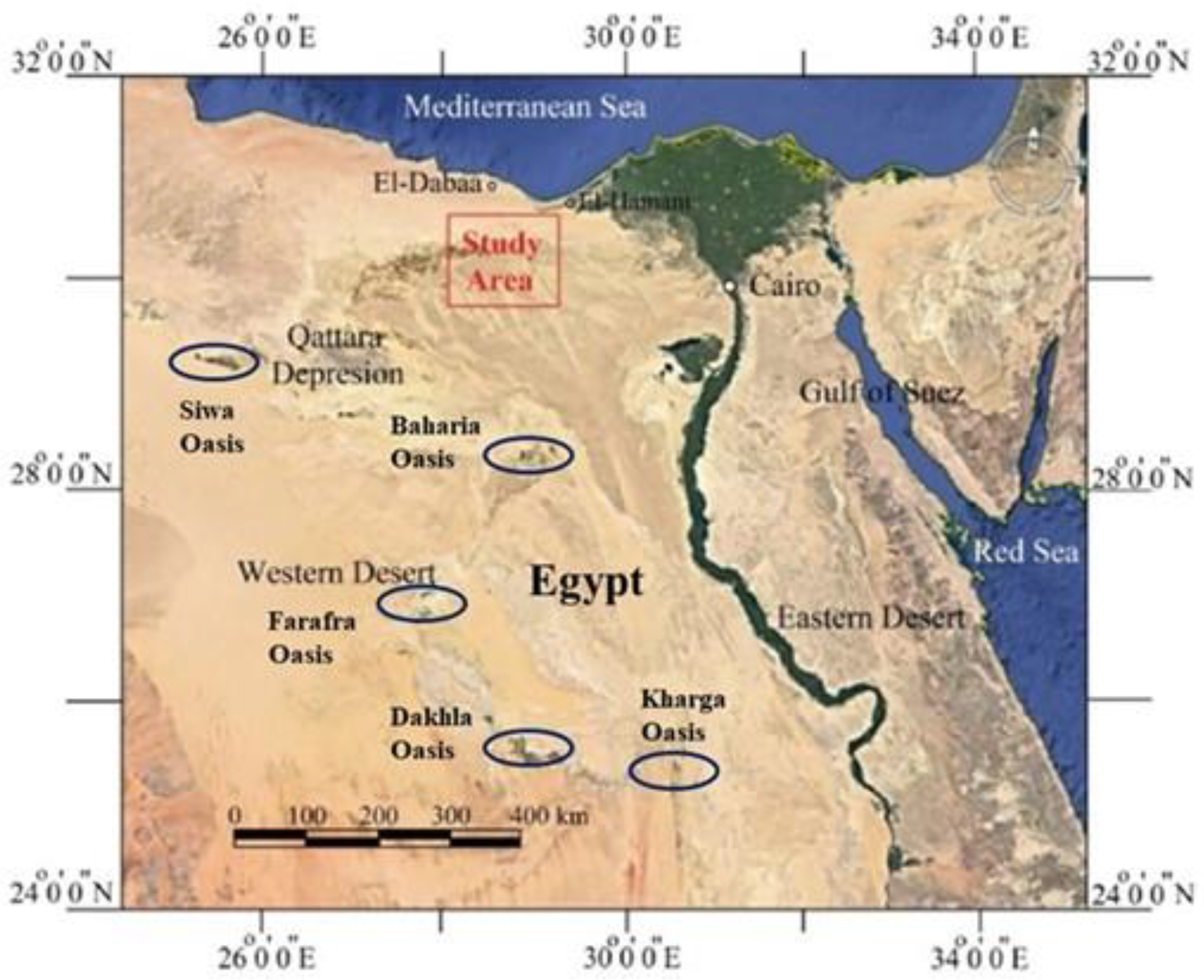
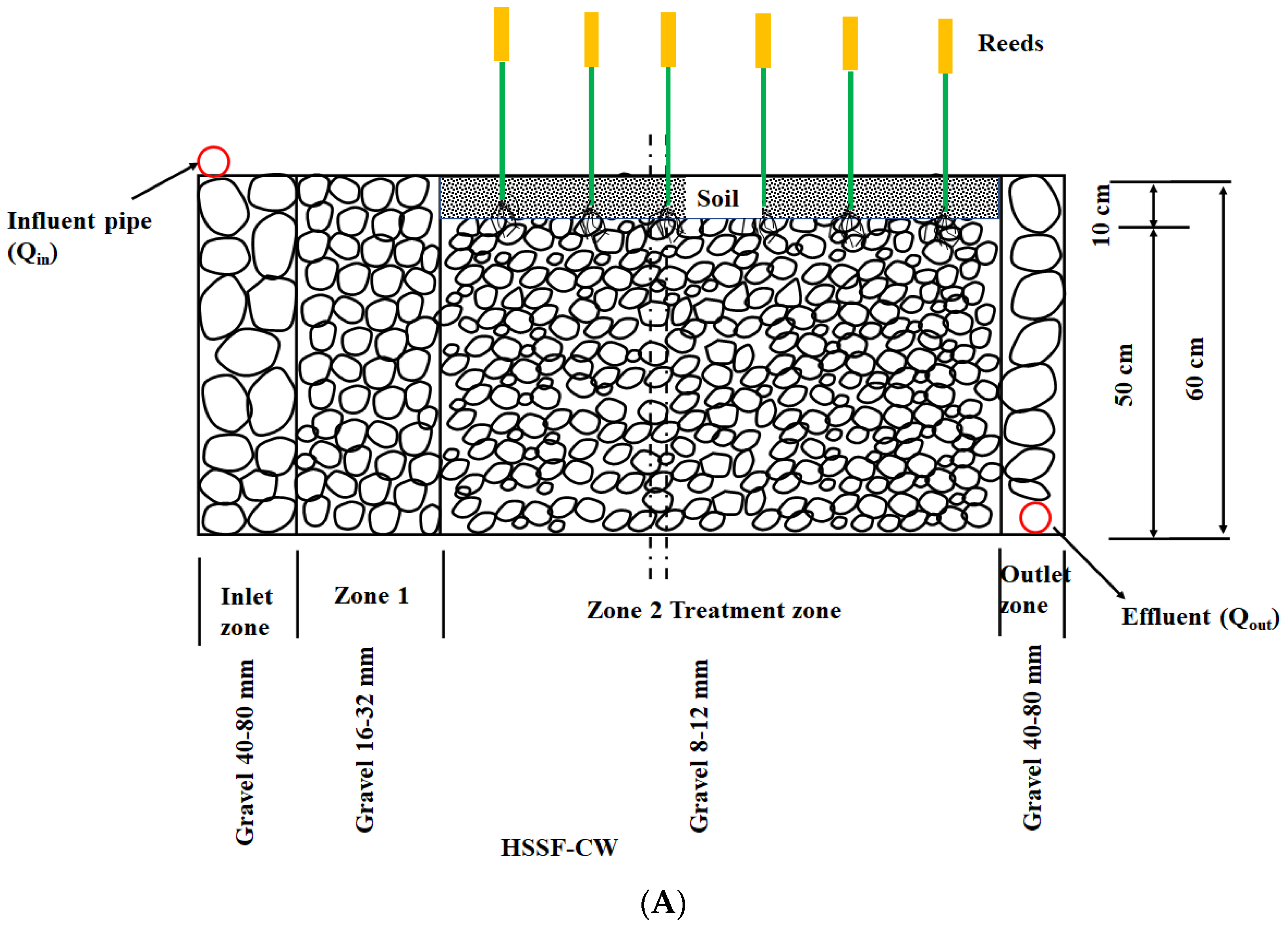
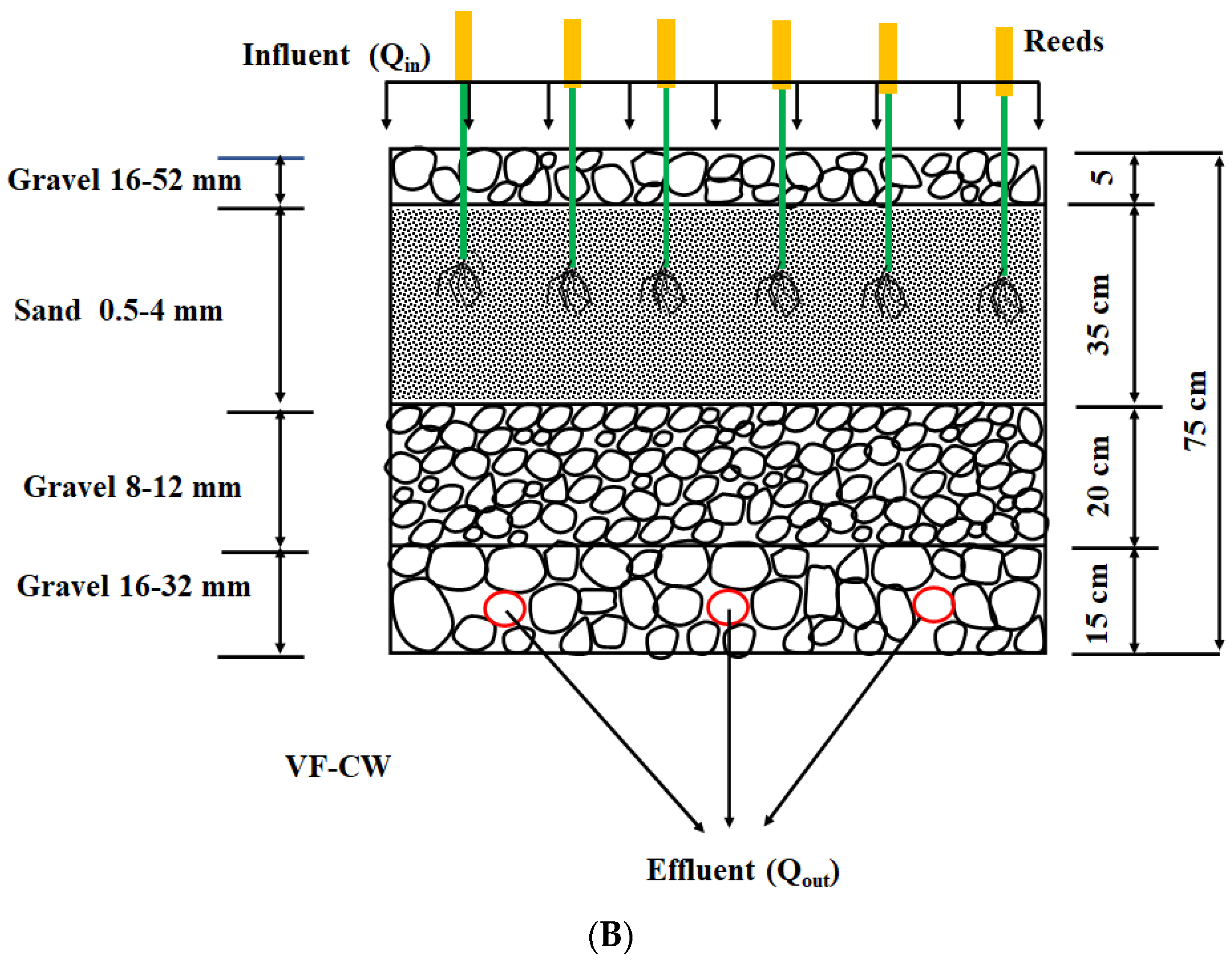



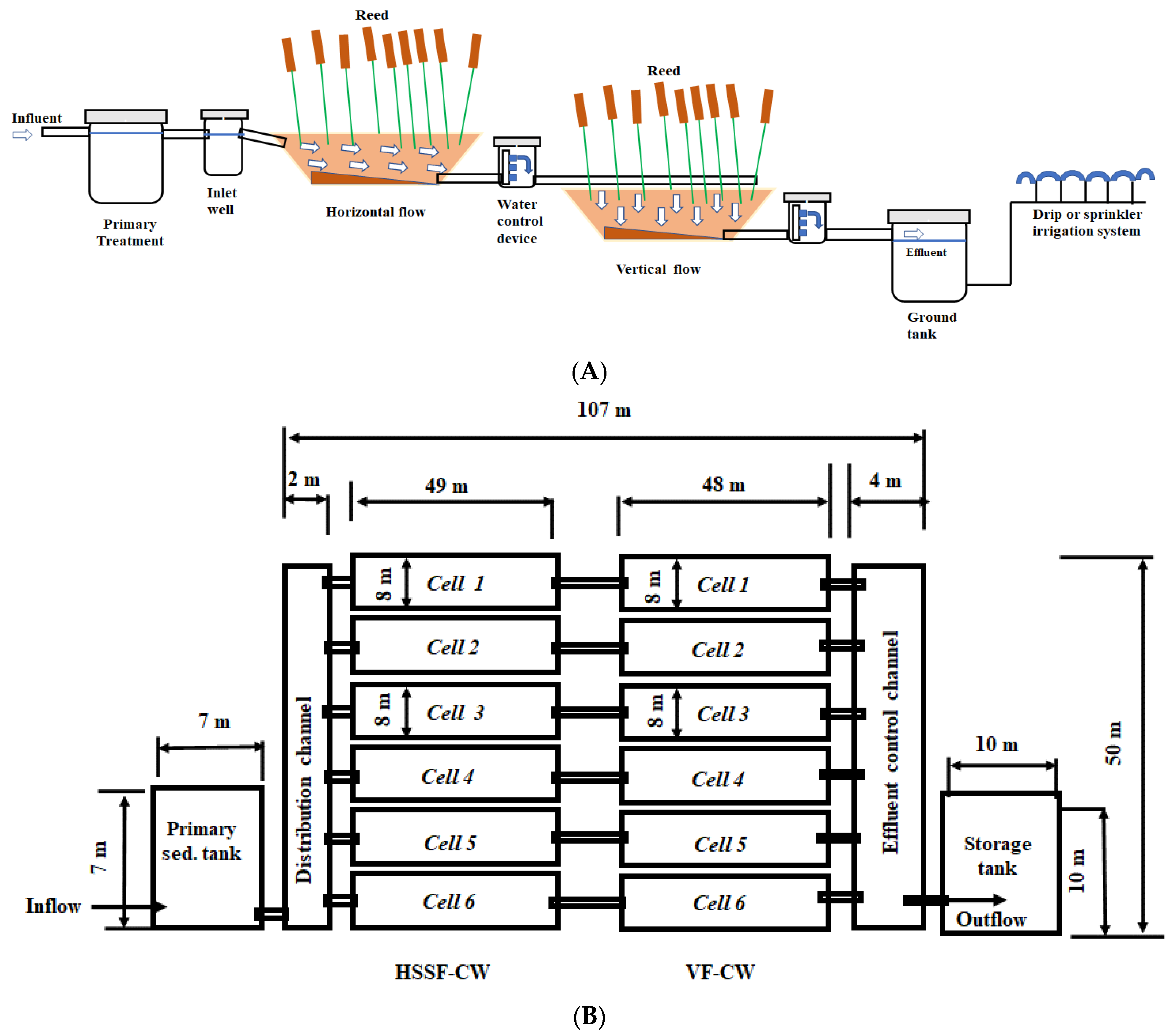
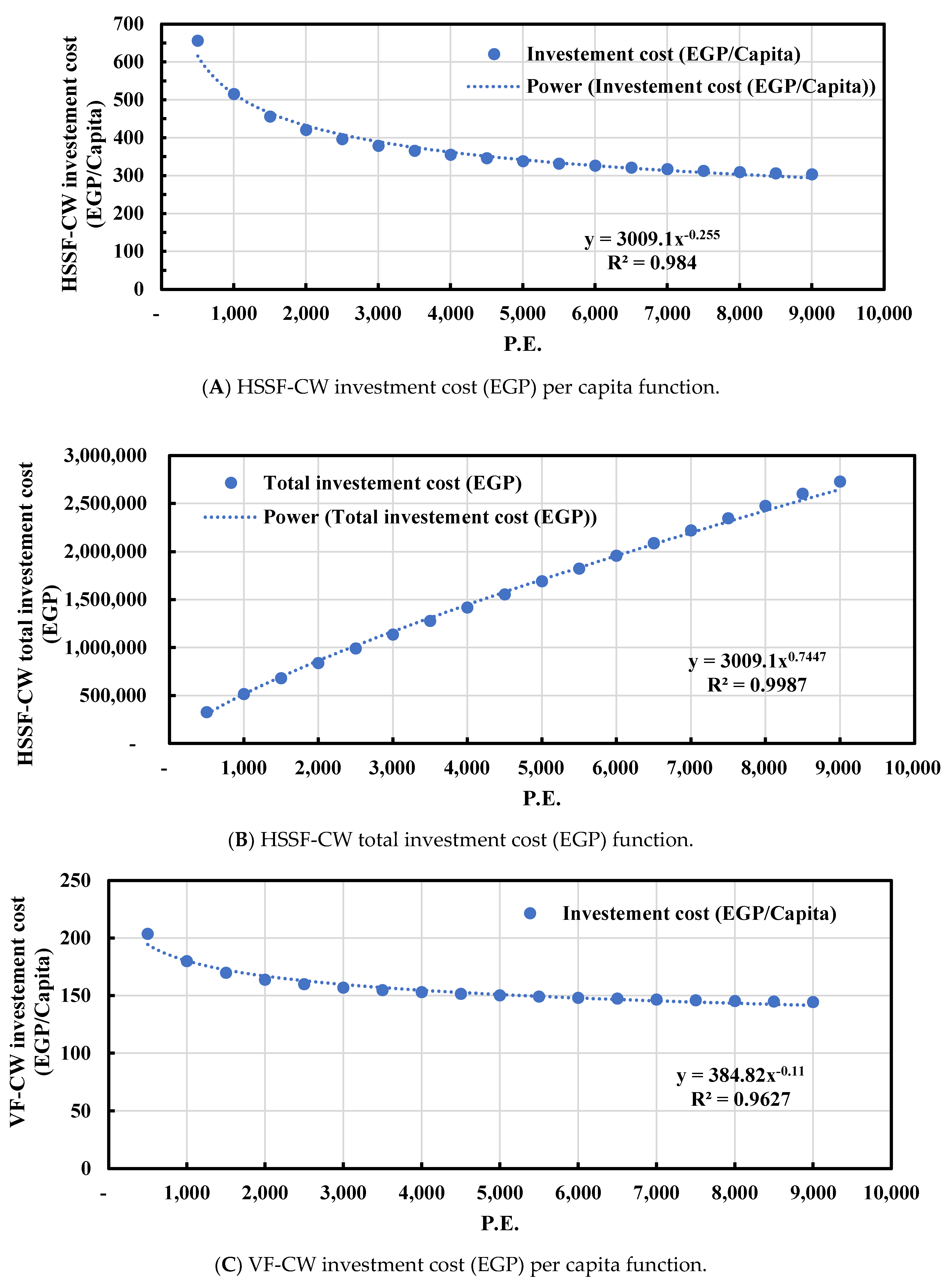
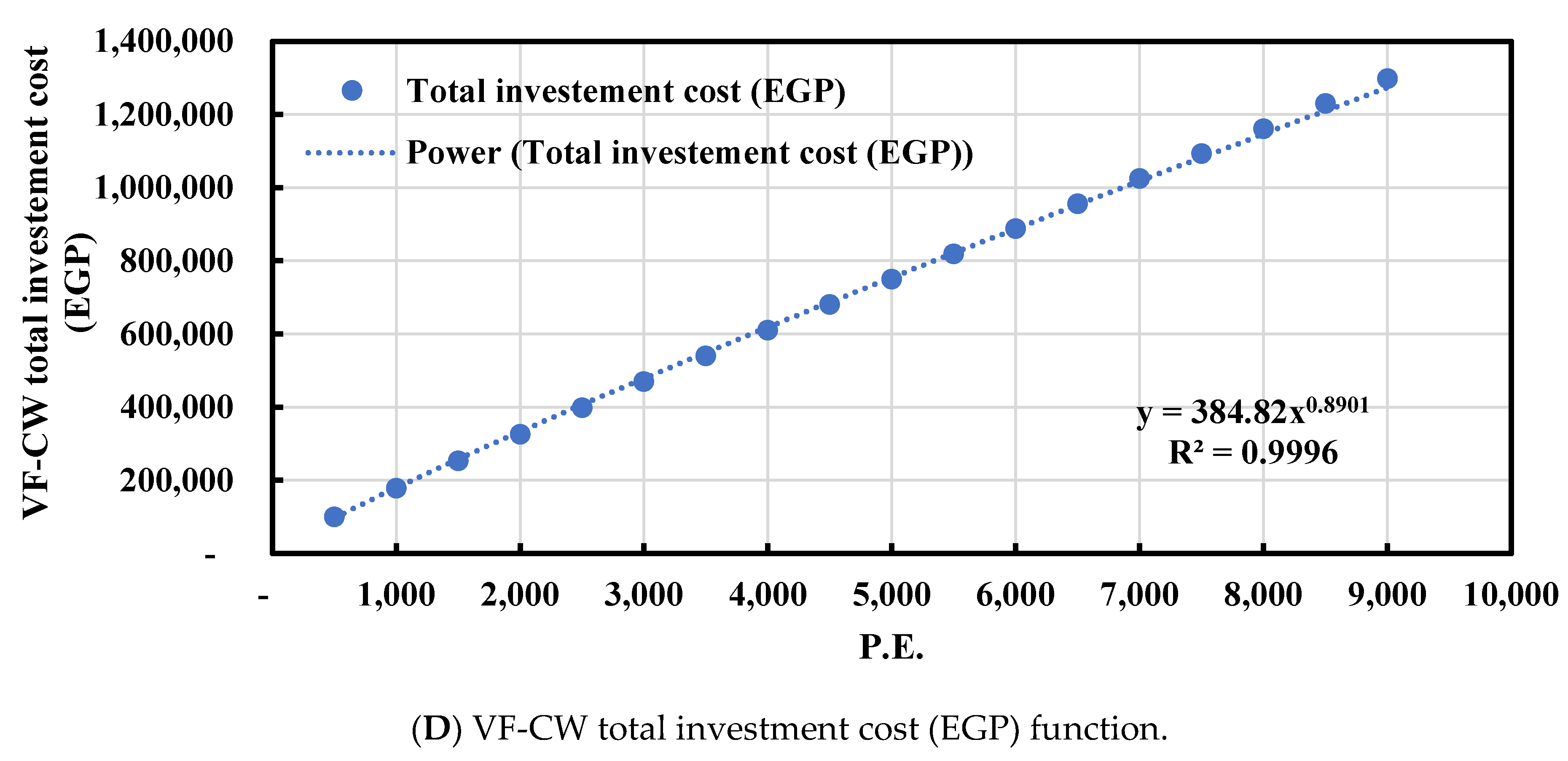
| Parameter | Unit | Influent Concentration Values | Effluent Concentration Values | Removal Efficiency (%) |
|---|---|---|---|---|
| COD | mg/L | 600 | 420 | 30 |
| BOD | mg/L | 300 | 210 | 30 |
| TP | mg/L | 10 | 7 | 30 |
| TN | mg/L | 43 | 30 | 30.2 |
| TSS | mg/L | 1000 | 400 | 60 |
| FC | Counts/100 mL | 107 | 106 | 90 |
| HSSF-CW | |||||||||||
|---|---|---|---|---|---|---|---|---|---|---|---|
| Q (m3/d) | Average Min. Temperature (°C) | Average Max. Temperature (°C) | Water Depth (m) | Apparent Number of RTS (P) | Influent Pollutants | C* | C | (m/d) | WE (%) | ||
| 780 | 14.2 | 24.4 | 0.3 | 0.6 | 3 | BOD (mg/L) | 210 | 1 | 50 | 0.662 | 76.2 |
| TP (mg/L) | 7 | 0.119 | 4.5 | 0.16 | 35.7 | ||||||
| FC (Counts/100 mL) | 106 | 4 | 104 | 1.492 | 99 | ||||||
| VF-CW | |||||||||||
| 780 | 14.2 | 24.4 | 0.75 | 3 | BOD (mg/L) | 50 | 1 | 10 | 0.662 | 80 | |
| TP (mg/L) | 4.5 | 0.119 | 3.0 | 0.16 | 33.3 | ||||||
| FC (Counts/100 mL) | 104 | 4 | 500 | 1.492 | 95 | ||||||
| HSSF-CW | |||
|---|---|---|---|
| BOD | TP | FC | |
| Area (m2) | 2198 | 2375 | 5712 |
| RT (d) | 0.5 | 0.55 | 1.3 |
| Surface load rate, q (m/d) | 0.35 | 0.33 | 0.33 |
| Efficiency (WE) (%) | 76.2 | 35.7 | 99 |
| Design values | |||
| Area (m2) | 2375 | ||
| RT (d) | 0.55 | ||
| Surface load rate, q (m/d) | 0.33 | ||
| Efficiency (WE) (%) | 78.2 | 35.7 | 93.7 |
| VF-CW | |||
| BOD | TP | FC | |
| Area (m2) | 2648 | 2193 | 2700 |
| RT (d) | 0.77 | 0.63 | 0.78 |
| Surface load rate, q (m/d) | 0.29 | 0.36 | 0.36 |
| Efficiency (WE) (%) | 80 | 33.3 | 95 |
| Design values | |||
| Area (m2) | 2193 | ||
| RT (d) | 0.63 | ||
| Surface load rate, q (m/d) | 0.36 | ||
| Efficiency (WE) (%) | 75 | 35.7 | 92.7 |
| Parameter | Unit | Influent Concentration Values | P.S Effluent | WE (%) | HSSF-CW Effluent | WE (%) | VF-CW Effluent | WE (%) | Overall Cumulative Efficiency WE (%) |
|---|---|---|---|---|---|---|---|---|---|
| BOD | mg/L | 300 | 210 | 30 | 50 | 76.2 | 10 | 80.0 | 96.67 |
| TP | mg/L | 10 | 7 | 30 | 4.5 | 35.7 | 3 | 33.3 | 70.00 |
| FC | Counts/100 mL | 10,000,000 | 1,000,000 | 90 | 10,000 | 99.0 | 500 | 95.0 | 100.00 |
| P.E. | Wastewater Consumption (WC) (m3/C/d) | Discharge (Q) (m3/d) | HSSF-CW Area (m2) | Number of Cells (n) | Length of Cell (L) (m) | Width of Cell (B) (m) | Aspect Ratio for CW | Aspect Ratio for Cell |
|---|---|---|---|---|---|---|---|---|
| 500 | 0.13 | 65 | 198 | 2 | 14.1 | 8 | 0.9 | 1.8 |
| 1000 | 0.13 | 130 | 396 | 2 | 19.9 | 8 | 1.2 | 2.5 |
| 1500 | 0.13 | 195 | 594 | 3 | 24.4 | 8 | 1.0 | 3.1 |
| 2000 | 0.13 | 260 | 792 | 3 | 28.1 | 8 | 1.2 | 3.5 |
| 2500 | 0.13 | 325 | 990 | 4 | 31.5 | 8 | 1.0 | 3.9 |
| 3000 | 0.13 | 390 | 1188 | 4 | 34.5 | 8 | 1.1 | 4.3 |
| 3500 | 0.13 | 455 | 1386 | 5 | 37.2 | 8 | 0.9 | 4.7 |
| 4000 | 0.13 | 520 | 1584 | 5 | 39.8 | 8 | 1.0 | 5.0 |
| 4500 | 0.13 | 585 | 1781 | 5 | 42.2 | 8 | 1.1 | 5.3 |
| 5000 | 0.13 | 650 | 1979 | 6 | 44.5 | 8 | 0.9 | 5.6 |
| 5500 | 0.13 | 715 | 2177 | 6 | 46.7 | 8 | 1.0 | 5.8 |
| 6000 | 0.13 | 780 | 2375 | 6 | 48.7 | 8 | 1.0 | 6.1 |
| 6500 | 0.13 | 845 | 2573 | 6 | 50.7 | 8 | 1.1 | 6.3 |
| 7000 | 0.13 | 910 | 2771 | 7 | 52.6 | 8 | 0.9 | 6.6 |
| 7500 | 0.13 | 975 | 2969 | 7 | 54.5 | 8 | 1.0 | 6.8 |
| 8000 | 0.13 | 1040 | 3167 | 7 | 56.3 | 8 | 1.0 | 7.0 |
| 8500 | 0.13 | 1105 | 3365 | 7 | 58 | 8 | 1.0 | 7.3 |
| 9000 | 0.13 | 1170 | 3563 | 7 | 59.7 | 8 | 1.1 | 7.5 |
| P.E. | Wastewater Consumption (WC) (m3/C/d) | Discharge (Q) (m3/d) | HSSF-CW Area (m2) | Number of Cells (n) | Length of Cell (L) (m) | Width of Cell (B) (m) | Aspect Ratio for CW | Aspect Ratio for Cell |
|---|---|---|---|---|---|---|---|---|
| 500 | 0.13 | 65 | 224 | 2 | 13.5 | 8 | 0.8 | 1.7 |
| 1000 | 0.13 | 130 | 366 | 2 | 19.1 | 8 | 1.2 | 2.4 |
| 1500 | 0.13 | 195 | 548 | 3 | 23.4 | 8 | 1.0 | 2.9 |
| 2000 | 0.13 | 260 | 731 | 3 | 27 | 8 | 1.1 | 3.4 |
| 2500 | 0.13 | 325 | 914 | 4 | 30.2 | 8 | 0.9 | 3.8 |
| 3000 | 0.13 | 390 | 1096 | 4 | 33.1 | 8 | 1.0 | 4.1 |
| 3500 | 0.13 | 455 | 1279 | 5 | 35.8 | 8 | 0.9 | 4.5 |
| 4000 | 0.13 | 520 | 1462 | 5 | 38.2 | 8 | 1.0 | 4.8 |
| 4500 | 0.13 | 585 | 1645 | 5 | 40.6 | 8 | 1.0 | 5.1 |
| 5000 | 0.13 | 650 | 1827 | 6 | 42.7 | 8 | 0.9 | 5.3 |
| 5500 | 0.13 | 715 | 2010 | 6 | 44.8 | 8 | 0.9 | 5.6 |
| 6000 | 0.13 | 780 | 2193 | 6 | 46.8 | 8 | 1.0 | 5.9 |
| 6500 | 0.13 | 845 | 2376 | 6 | 48.7 | 8 | 1.0 | 6.1 |
| 7000 | 0.13 | 910 | 2558 | 7 | 50.6 | 8 | 0.9 | 6.3 |
| 7500 | 0.13 | 975 | 2741 | 7 | 52.4 | 8 | 0.9 | 6.6 |
| 8000 | 0.13 | 1040 | 2924 | 7 | 54.1 | 8 | 1.0 | 6.8 |
| 8500 | 0.13 | 1105 | 3107 | 7 | 55.7 | 8 | 1.0 | 7.0 |
| 9000 | 0.13 | 1170 | 3289 | 7 | 57.4 | 8 | 1.0 | 7.2 |
| Month | Inflow (m3/d) | Rainfall (mm/d) | Rainfall (m3/d) | ETo (mm/d) | ETo (m3/d) | Outflow (m3/d) | Water Losses (%) |
|---|---|---|---|---|---|---|---|
| January | 780 | 1.0 | 2.4 | 2.9 | 17.2 | 765.2 | 1.9 |
| February | 780 | 0.6 | 1.4 | 3.47 | 20.6 | 761.9 | 2.3 |
| March | 780 | 0.3 | 0.6 | 3.99 | 23.7 | 758.8 | 2.7 |
| April | 780 | 0.1 | 0.2 | 4.96 | 29.5 | 753.1 | 3.5 |
| May | 780 | 0.1 | 0.2 | 5.5 | 32.7 | 749.8 | 3.9 |
| June | 780 | 0.0 | 0.1 | 5.99 | 35.6 | 746.9 | 4.2 |
| July | 780 | 0.0 | 0.0 | 6.02 | 35.7 | 746.8 | 4.3 |
| August | 780 | 0.0 | 0.0 | 6.03 | 35.8 | 746.7 | 4.3 |
| September | 780 | 0.0 | 0.1 | 5.43 | 32.2 | 750.3 | 3.8 |
| October | 780 | 0.4 | 0.9 | 4.45 | 26.4 | 756.1 | 3.1 |
| November | 780 | 0.5 | 1.2 | 3.6 | 21.4 | 761.1 | 2.4 |
| December | 780 | 0.9 | 2.1 | 3.04 | 18.1 | 764.5 | 2.0 |
| Month | Inflow (m3/d) | Rainfall (mm/d) | Rainfall (m3/d) | ETo (mm/d) | ETo (m3/d) | Outflow (m3/d) | Water Losses (%) |
|---|---|---|---|---|---|---|---|
| January | 780 | 1.0 | 2.9 | 2.9 | 15.9 | 766.3 | 1.8 |
| February | 780 | 0.6 | 3.47 | 3.47 | 19.0 | 762.3 | 2.3 |
| March | 780 | 0.3 | 3.99 | 3.99 | 21.9 | 758.7 | 2.7 |
| April | 780 | 0.1 | 4.96 | 4.96 | 27.2 | 753.0 | 3.5 |
| May | 780 | 0.1 | 5.5 | 5.5 | 30.2 | 750.0 | 3.8 |
| June | 780 | 0.0 | 5.99 | 5.99 | 32.8 | 747.2 | 4.2 |
| July | 780 | 0.0 | 6.02 | 6.02 | 33.0 | 747.0 | 4.2 |
| August | 780 | 0.0 | 6.03 | 6.03 | 33.1 | 746.9 | 4.2 |
| September | 780 | 0.0 | 5.43 | 5.43 | 29.8 | 750.3 | 3.8 |
| October | 780 | 0.4 | 4.45 | 4.45 | 24.4 | 756.5 | 3.0 |
| November | 780 | 0.5 | 3.6 | 3.6 | 19.7 | 761.3 | 2.4 |
| December | 780 | 0.9 | 3.04 | 3.04 | 16.7 | 765.3 | 1.9 |
| Type of Wetland | Temp. (°C) | Plants | Discharge (m3/d) | Pollutants Concentrations | Removal Efficiency (%) | Surface Area (A) (ha) | |
|---|---|---|---|---|---|---|---|
| Inlet Flow (Ci) (mg/L) | Outlet Flow (C) (mg/L) | ||||||
| Proposed HSSF-CW | 14.2–24.4 | Phragmites australis and Papyrus | 780 | BOD = 210 TP = 7 FC = 106 (Counts/100 mL) | BOD = 46 TP = 4.5 FC = 6.3 106 (Counts/100 mL) | BOD = 78.2 TP = 35.7 FC = 93.7 | 0.2735 |
| Proposed VF-CW | 14.2–24.4 | Phragmites australis and Papyrus | 780 | BOD = 46 TP = 4.5 FC = 104 (Counts/100 mL) | BOD = 11.5 TP = 2.9 FC = 4599 (Counts/100 mL) | BOD = 75 TP = 33.7 FC = 92.7 | 0.2193 |
| HSSF-CW -Pilot scale in Karachi, NED University of Engineering and Technology [49] | 20-36 | Phragmites australis | 1 | BOD = 68.6 ± 23.6 TP = 7.6 ± 1.9 FC = 1.1 × 106 (Counts/100 mL) | BOD = 34.15 ± 15.5 TP = 3.7 ± 2.3 FC = 2.2 104 (Counts/100 mL) | BOD = 50 TP = 52 FC = 98 | - |
| Lake Manzala reciprocating wetland system, Egypt [43] | 14.1–27.8 | Unplanted | 250 | BOD = 25 FC = 3342 (Counts/100 mL) | BOD = 4 FC = 153 (Counts/100 mL) | BOD = 84 FC = 95.4 | 0.0324 |
| Agaa wastewater treatment, Delta of Egypt [30,50]. | 18 | Phragmites australis and Papyrus | 1500 | BOD = 250 | BOD = 60 | BOD = 76 | 0.184 |
Disclaimer/Publisher’s Note: The statements, opinions and data contained in all publications are solely those of the individual author(s) and contributor(s) and not of MDPI and/or the editor(s). MDPI and/or the editor(s) disclaim responsibility for any injury to people or property resulting from any ideas, methods, instructions or products referred to in the content. |
© 2023 by the authors. Licensee MDPI, Basel, Switzerland. This article is an open access article distributed under the terms and conditions of the Creative Commons Attribution (CC BY) license (https://creativecommons.org/licenses/by/4.0/).
Share and Cite
Gabr, M.E.; Al-Ansari, N.; Salem, A.; Awad, A. Proposing a Wetland-Based Economic Approach for Wastewater Treatment in Arid Regions as an Alternative Irrigation Water Source. Hydrology 2023, 10, 20. https://doi.org/10.3390/hydrology10010020
Gabr ME, Al-Ansari N, Salem A, Awad A. Proposing a Wetland-Based Economic Approach for Wastewater Treatment in Arid Regions as an Alternative Irrigation Water Source. Hydrology. 2023; 10(1):20. https://doi.org/10.3390/hydrology10010020
Chicago/Turabian StyleGabr, Mohamed Elsayed, Nadhir Al-Ansari, Ali Salem, and Ahmed Awad. 2023. "Proposing a Wetland-Based Economic Approach for Wastewater Treatment in Arid Regions as an Alternative Irrigation Water Source" Hydrology 10, no. 1: 20. https://doi.org/10.3390/hydrology10010020









